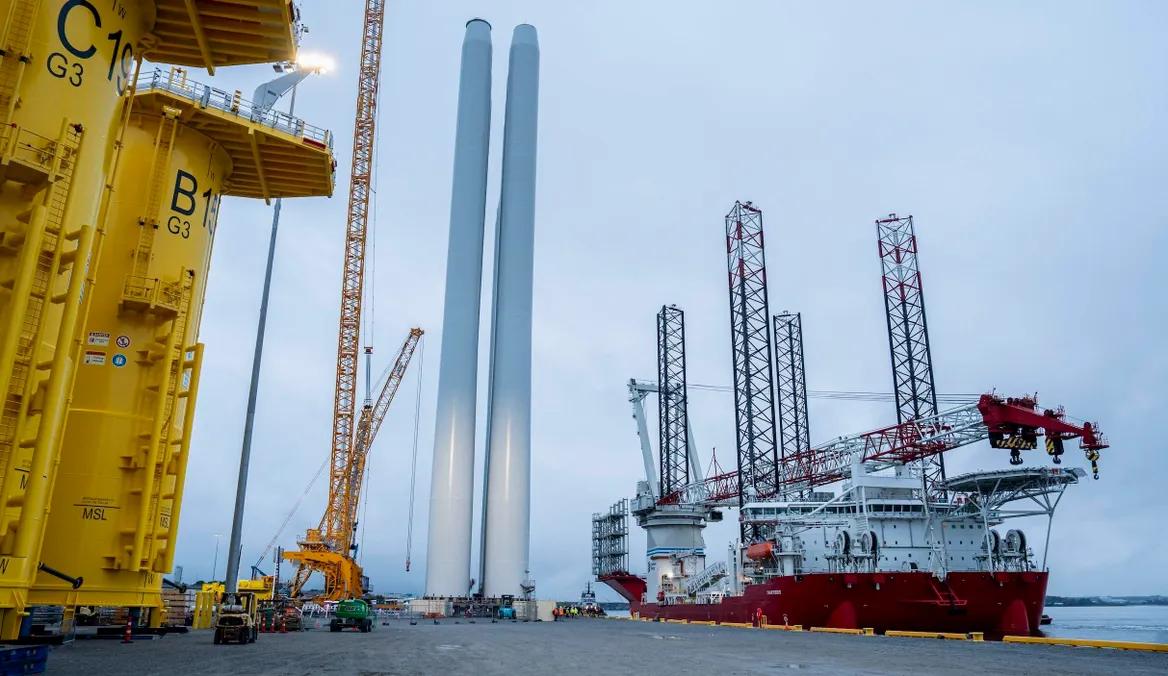About 30 miles off the coast of Virginia Beach, Virginia, workers have been building America’s largest offshore wind farm at a breakneck pace. The project will start feeding power to the grid by March — the most definitive start date provided by its developer yet.
“First power will occur in Q1 of next year,” Dominion Energy spokesperson Jeremy Slayton told Canary Media. “And we are still on schedule to complete by late 2026.”
In an August earnings call, Dominion Energy CEO Robert Blue provided a vague window of “early 2026” when asked when the 2.6-gigawatt Coastal Virginia Offshore Wind, or CVOW, project would start generating renewable power for the energy-hungry state.
As of the end of September, Dominion had installed all 176 turbine foundations — “a big, important milestone,” per Slayton. That accomplishment involved pile-driving 98 foundations into the soft seabed during the five-month stretch when such work is permitted. Good weather helped the work move along quickly, as did the Atlantic Ocean’s unusually quiet hurricane season.
Speed is key when building wind projects under the eye of a president who has called turbines “ugly” and “terrible for tourism” — and who has followed up with attempts to dismantle the industry.
Had CVOW not finished foundation installation by the end of this month, turbine construction would have been delayed until next spring. Federal permitting restricts pile-driving to a May-through-October window to protect migrating North Atlantic right whales. Such a delay would have made CVOW more vulnerable to the wrath of the Trump administration, which has already issued stop-work orders to two offshore wind farms under construction.

Dominion Energy
But Slayton said the threat of President Donald Trump’s interference doesn’t concern him. CVOW is, after all, 1 of only 2 in-progress offshore wind projects that hasn’t been directly attacked by the president.
“Our project has enjoyed bipartisan support from the beginning,” he said, pointing to backing from some of the state’s leading Republicans, including Governor Glenn Youngkin and U.S. Representative Jen Kiggans.
Kiggans, who represents the politically moderate Virginia Beach area, brought her concerns about Trump’s escalating war on wind to the House floor last month, when Congress returned from recess. She called CVOW “important to Virginia,” and House Speaker Mike Johnson, a Republican from Louisiana, later told reporters that he relayed Kiggans’ message directly to Trump.
“I understand the priority for Virginians and we want to do right by them, so we’ll see,” Johnson told Politico’s E&E News, in a comment that broke from an anti–offshore wind narrative that’s taken root among many of his fellow House Republicans.
The project is crucial for helping the state meet a deluge of new electricity demand, as Virginia is at the center of the nationwide boom in data-center construction. CVOW will provide a huge amount of carbon-free power to the state and Dominion, its largest utility — helping both keep pace with rising demand without having to burn more polluting fossil fuels.
Kiggans also tied the success of CVOW to the needs of Virginia’s military installations.

“I always speak about that project in light of the national security benefit and that benefit to Naval Air Station Oceana,” Kiggans said last month in an interview with WAVY, a Virginia news station, noting that a partnership with Dominion is “giving Naval Air Station Oceana a $500 million power grid upgrade.”
Dominion has already spent $6 billion on the monumental effort to build CVOW, which has been 12 years in the making. Almost $1 billion of that investment has flowed to the local economy, creating 802 full- and part-time jobs in the state’s Hampton Roads region, according to G.T. Hollett, Dominion Energy’s director of offshore wind.
CVOW’s benefits are being felt nationwide too.
“The project has already created 2,000 direct and indirect American jobs and generated $2 billion in economic activity, strengthening the nation’s manufacturing supply chains and our regional economy,” said Katharine Kollins, president of Southeastern Wind Coalition.
Now Dominion will turn to the final phase of construction: turbine installation. The work is made possible by Charybdis — the first U.S.-built, Jones Act–compliant wind-turbine installation vessel — which arrived in Virginia’s Portsmouth Marine Terminal last month.
“When Charybdis is loaded up, it will have all the components to install four turbines with each trip,” said Slayton, who noted that the pace of the build is well timed given Virginia’s data center boom. The state is facing “record growth and energy demand … maybe you’ve heard.”


